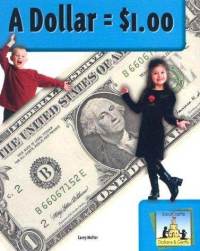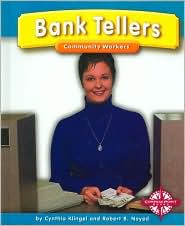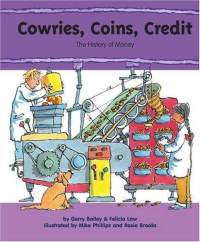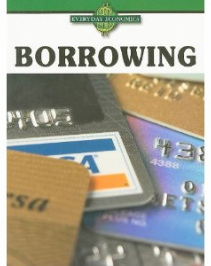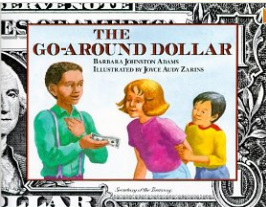Children's Literature- Nonfiction A-L
Click on any picture of a book to open a new external window with the Amazon.com listing of that book.
Title: A Dollar =$1.00
Author: Carey Molter
Publication: 2003, SandCastle Publishing
ISBN #: Unavailable
Theme: Money Knowledge
Recommended for Grade Levels: K through 1
Assessment Rating: 3-Fair
Assessment:
A very basic book on the dollar bill. This would be a great book for independent reading and a book to have in the classroom to reference when teaching a unit on US money and coins. This book also expresses the dollar bill in various other forms such as quarters, nickels, dimes, and pennies. A solid introduction to money with age appropriate language used throughout.
A very basic book on the dollar bill. This would be a great book for independent reading and a book to have in the classroom to reference when teaching a unit on US money and coins. This book also expresses the dollar bill in various other forms such as quarters, nickels, dimes, and pennies. A solid introduction to money with age appropriate language used throughout.
Title: Ancient Coins Were Shaped Like Hams and Other Freaky Facts About
Coins Bills and Counterfeiting
Author: Barbara Seuling
Illustrator: Mathew Skeens
Publication: 2008, Picture Window Books
ISBN #: 1404837558
Theme: Money Knowledge
Recommended for Grade Levels: 4 through 6
Assessment Rating: 3-Fair
Assessment:
This book is unique in the sense of it’s solely “freaky facts”. This book is full of facts about coins, paper money, counterfeiting, and worldly customs. This is a fun book for the teacher to share fun facts through a read aloud, or as an independent read for a unit on economics. Each of the "freaky facts" could be used as a prompt for a writing assignment that ties the concepts of economics very nicely into language arts.
This book is unique in the sense of it’s solely “freaky facts”. This book is full of facts about coins, paper money, counterfeiting, and worldly customs. This is a fun book for the teacher to share fun facts through a read aloud, or as an independent read for a unit on economics. Each of the "freaky facts" could be used as a prompt for a writing assignment that ties the concepts of economics very nicely into language arts.
Title: Around the World with Money
Author: Tim Clifford
Publication: 2009, Rourke Publishing LLC
ISBN #: 1604729791
Theme: Money Knowledge
Recommended for Grade Levels: 3-6
Assessment Rating: 4-Good
Assessment:
This book is an introduction to different currencies of various countries and nations. The first chapter is an introductory chapter about what money is and how each country has money which it uses to buy goods and services. Each of the remaining chapters are broken down into a different country currencies. It gives specific facts about the different currencies and if they had currencies prior to the one they have now it gives a little history of the currency. The last portion of the book explains currency exchanges and how money is not the same value everywhere in the world. It is great for older elementary students and has a strong glossary of terms to learn. This type of book also shows the global nature of our economy and the interdependence that the United States has in relationship to other nations.
This book is an introduction to different currencies of various countries and nations. The first chapter is an introductory chapter about what money is and how each country has money which it uses to buy goods and services. Each of the remaining chapters are broken down into a different country currencies. It gives specific facts about the different currencies and if they had currencies prior to the one they have now it gives a little history of the currency. The last portion of the book explains currency exchanges and how money is not the same value everywhere in the world. It is great for older elementary students and has a strong glossary of terms to learn. This type of book also shows the global nature of our economy and the interdependence that the United States has in relationship to other nations.
Title: Bank Tellers. Community Workers
Author: Cynthia Klingel & Robert B. Noyed
Publication: 2003, Compass Point Books.
ISBN #: 0756511852
Theme: Managing Money
Recommended for Grade Levels: 1-2
Assessment Rating: 3-Fair
Assessment:
This book is an introduction to a bank teller and how bank tellers help our communities. The book goes over the various job duties of a bank teller as well some of the ways bank tellers can help young children with understanding money and starting savings accounts. The book reiterates how bank tellers are a vital resource to each community they serve in. The book is specified for students in grades K-2 as it gives very basic information. The book is very informational and easy to understand. It provides pictures of tellers performing their duties on each page. It would be a good book to use as an introductory to saving unit for young grades.
This book is an introduction to a bank teller and how bank tellers help our communities. The book goes over the various job duties of a bank teller as well some of the ways bank tellers can help young children with understanding money and starting savings accounts. The book reiterates how bank tellers are a vital resource to each community they serve in. The book is specified for students in grades K-2 as it gives very basic information. The book is very informational and easy to understand. It provides pictures of tellers performing their duties on each page. It would be a good book to use as an introductory to saving unit for young grades.
Title: Budgeting Tips for Kids
Author: Tamera Orr
Publication: 2009, Mitchell Lane Publishers
ISBN #: 9781584156444
Theme: Managing Money
Recommended for Grade Levels: 3 through 5
Assessment Rating: 4-Good
Assessment:
Like some of the other books for older elementary school grade levels, this book would be useful as both a reference and an independent reading book. The book tackles the idea of budgeting in the context of the character Michael and his desire to purchase a Playstation®. This is an interesting approach to what could be a dry subject. It also makes it relevant to the target audience for the book. The photographs in the book are excellent as well. It covers vocabulary such as overextended, income, expenses, discount, comparison shopping, and investments. Finally, the book also provides a number of websites for further investigations. This is a very good resource for elementary school teachers.
Like some of the other books for older elementary school grade levels, this book would be useful as both a reference and an independent reading book. The book tackles the idea of budgeting in the context of the character Michael and his desire to purchase a Playstation®. This is an interesting approach to what could be a dry subject. It also makes it relevant to the target audience for the book. The photographs in the book are excellent as well. It covers vocabulary such as overextended, income, expenses, discount, comparison shopping, and investments. Finally, the book also provides a number of websites for further investigations. This is a very good resource for elementary school teachers.
Title: Cowries, Coins, Credit-The History of Money
Author: Gerry Bailey & Felicia Law
Illustrator: Mike Phillips & Rosie Brooks
Publication: 2006, Allegra Publishing
ISBN #: 9780756516765
Theme: Money Knowledge
Recommended for Grade Levels: 4-6
Assessment Rating: 4-Good
Assessment:
This book is about the evolution of money. It begins with how people needed to figure out a standardized system for trading goods. It covers how it was difficult to determine the value of different items because the values were different according to the item and the person acquiring or trading the item. The book covers coins and how they were produced as well as treasure hunting, mining for gold, money forgery, paper money and the different kinds of money used by different countries through the ages of civilization. The last portion of the book is a detailed glossary with interesting terms used for different types of money throughout the centuries in different countries. The book also provides additional websites where students can learn more about the history of money.
This book is about the evolution of money. It begins with how people needed to figure out a standardized system for trading goods. It covers how it was difficult to determine the value of different items because the values were different according to the item and the person acquiring or trading the item. The book covers coins and how they were produced as well as treasure hunting, mining for gold, money forgery, paper money and the different kinds of money used by different countries through the ages of civilization. The last portion of the book is a detailed glossary with interesting terms used for different types of money throughout the centuries in different countries. The book also provides additional websites where students can learn more about the history of money.
Title: Creating a Budget
Author: Gillian Houghton
Publication: 2009, The Rosen Publishing Group Inc
ISBN #: 1435832094
Theme: Managing Money
Recommended for Grade Levels: 2-3
Assessment Rating: 4-Good
Assessment:
This is a children’s book aimed at keeping track of one’s expenses and adhering to a budget. The book concentrates on budgeting and differentiating between wants and needs. This book is a step by step guide on how a child can master his/her finances. The book does a nice job with keeping it simple. The chapters are very short and direct which makes them easier for a second or third grader to understand. Each chapter deals with another step in the process of adhering to the budget. There is a short glossary of financial terms to broaden the reader’s vocabulary. There are also websites the reader can go to that will help them find out more information and tips about building a strong budgeting foundation.
This is a children’s book aimed at keeping track of one’s expenses and adhering to a budget. The book concentrates on budgeting and differentiating between wants and needs. This book is a step by step guide on how a child can master his/her finances. The book does a nice job with keeping it simple. The chapters are very short and direct which makes them easier for a second or third grader to understand. Each chapter deals with another step in the process of adhering to the budget. There is a short glossary of financial terms to broaden the reader’s vocabulary. There are also websites the reader can go to that will help them find out more information and tips about building a strong budgeting foundation.
Title: Currency
Author: Patricia K. Kumer
Publication: 2004, Franklin Watts, a Division of Scholastic Inc.
ISBN #: 0531167348
Theme: Money Knowledge
Recommended for Grade Levels: 4 through 6
Assessment Rating: 5-Excellent
Assessment:
This book provides significant details about currency. It is appropriate for either a reference book or for independent reading for Grades 4 through 6. It provides significant details about currency including:
It also provides a detailed glossary and a timeline of events. We particularly like the illustrations in this book which range from drawings/paintings from the 1400s to photographs of modern day credit card processing centers. The book also provides vignettes in boxed sections throughout the book (e.g., counterfeiting). The history of currency across time and across the globe is the key take-away for this book.
This book provides significant details about currency. It is appropriate for either a reference book or for independent reading for Grades 4 through 6. It provides significant details about currency including:
- What is currency?
- Bartering systems and early currency
- Who invented modern currency?
- How money is made and who is responsible for making it
It also provides a detailed glossary and a timeline of events. We particularly like the illustrations in this book which range from drawings/paintings from the 1400s to photographs of modern day credit card processing centers. The book also provides vignettes in boxed sections throughout the book (e.g., counterfeiting). The history of currency across time and across the globe is the key take-away for this book.
Title: Do I Need It? Or Do I Want It? Making Budget Choices
Author: Jennifer S. Larson
Publication: 2010, Lerner Publication Company
ISBN #: 9780761356646
Theme: Need vs. Wants
Recommended for Grade Levels: 2 through 3
Assessment Rating: 5-Excellent
Assessment:
This book is perfect for a mid- to late-year Grade 2 into Grade 3 student. It covers a number of economic topics in terms that a child of 6-7 years can easily understand. The discussion all comes from a child’s point of view which is an excellent model. It would be great for an independent or shared reading assignment. The concepts covered within this book include: allowance, budgets, wants vs. needs, goods and services, income, and savings. It even highlights donations. The best part of this text is that it clearly shows the difference between what a child might want (e.g., candy, a bicycle, a soda) versus what that child’s family needs to survive (e.g., food, housing, etc.).
This book is perfect for a mid- to late-year Grade 2 into Grade 3 student. It covers a number of economic topics in terms that a child of 6-7 years can easily understand. The discussion all comes from a child’s point of view which is an excellent model. It would be great for an independent or shared reading assignment. The concepts covered within this book include: allowance, budgets, wants vs. needs, goods and services, income, and savings. It even highlights donations. The best part of this text is that it clearly shows the difference between what a child might want (e.g., candy, a bicycle, a soda) versus what that child’s family needs to survive (e.g., food, housing, etc.).
Title: Everyday Economics: Borrowing
Author: Tatiana Tomljanovic
Photography: Getty Images
ISBN#: 1605966460
Theme: Borrowing, credit, interest rates, history of money
Recommended for Grade Level: 4-8
Assessment Rating:5-excellent
Assessment:
This book is full of economic vocabulary and concepts and is a great informational text for upper grade children or even adults. The glossy photographs make it an attractive layout, and the font is large enough so as not to be intimidating. There is a quiz at the end of the book, as well as a glossary, an index, and suggestions for further research, including websites and library tips. This would be an ideal text to have available for independent study to students with an interest in business, economics, or money, or for enrichment for exceptional children.
Author: Tatiana Tomljanovic
Photography: Getty Images
ISBN#: 1605966460
Theme: Borrowing, credit, interest rates, history of money
Recommended for Grade Level: 4-8
Assessment Rating:5-excellent
Assessment:
This book is full of economic vocabulary and concepts and is a great informational text for upper grade children or even adults. The glossy photographs make it an attractive layout, and the font is large enough so as not to be intimidating. There is a quiz at the end of the book, as well as a glossary, an index, and suggestions for further research, including websites and library tips. This would be an ideal text to have available for independent study to students with an interest in business, economics, or money, or for enrichment for exceptional children.
Title: The Federal Reserve Act – Making the American Banking System Stronger
Author: Melanie Ann Apel
Publication: 2006, Rosen Publishing Group
ISBN #: 1404208631
Theme: Money Knowledge
Recommended for Grade Levels: 4 through 6
Assessment Rating: 3-Fair
Assessment:
This book covers a number of areas including: the Progressive Movement (who wanted to put more power in the hands of working class versus the rich), why the United Stated Needed a Federal Reserve Act (problems existed with currency and with the banking system), an explanation of the Federal Reserve System, and a discussion of the banks of the Federal Reserve System (12 districts across the United States). This book is targeted at the higher grades in elementary school. It provides the technical details and history around the Federal Reserve System, authentic photographs from the early 1900s, and an easy-to-understand glossary of key terms. This book is also a good quick overview of the history of the Federal Reserve for teachers. This book would be a good source to be used in an ecomonics-focused research project in older elementary grades.
This book covers a number of areas including: the Progressive Movement (who wanted to put more power in the hands of working class versus the rich), why the United Stated Needed a Federal Reserve Act (problems existed with currency and with the banking system), an explanation of the Federal Reserve System, and a discussion of the banks of the Federal Reserve System (12 districts across the United States). This book is targeted at the higher grades in elementary school. It provides the technical details and history around the Federal Reserve System, authentic photographs from the early 1900s, and an easy-to-understand glossary of key terms. This book is also a good quick overview of the history of the Federal Reserve for teachers. This book would be a good source to be used in an ecomonics-focused research project in older elementary grades.
Title: The Go-Around Dollar
Author: Barbara Johnston Adams
Illustrator: Joyce Audy Zarins
ISBN#: 0027000311
Theme: Money, the American dollar bill, Counterfeit money
Recommended for Grade Level: 2-4
Assessment Rating: 4-Good
Assessment:
This story shows how a single dollar bill circulates through an economy. On each page, there are also trivia and facts about American money and the dollar bill. This book would work well as a read-aloud for lower grades, especially if students are given a real dollar bill to inspect during the reading. Older grades will enjoy this as an independent or buddy reading. This book would be an ideal source for center activities.
Author: Barbara Johnston Adams
Illustrator: Joyce Audy Zarins
ISBN#: 0027000311
Theme: Money, the American dollar bill, Counterfeit money
Recommended for Grade Level: 2-4
Assessment Rating: 4-Good
Assessment:
This story shows how a single dollar bill circulates through an economy. On each page, there are also trivia and facts about American money and the dollar bill. This book would work well as a read-aloud for lower grades, especially if students are given a real dollar bill to inspect during the reading. Older grades will enjoy this as an independent or buddy reading. This book would be an ideal source for center activities.
Title: If You Made A Million
Author: David M. Schwartz
Illustrator: Steven Kellogg
Publication: 1989, Harper Collins Publishers
ISBN #: 0688136346
Theme: Managing Money, Income
Recommended for Grade Levels: 1 through 3
Assessment Rating: 4-Good
Assessment:
Great read for future capitalists. This is a wonderful book about “making money means making choices”. This book walks the reader all the way through earning a penny to earning a million dollars. The author shows the reader what money looks like when interest is accrued over short and long periods of time. This is a great book for kids 4-6 who want to read a picture book or even older kids who want to know how interest and banking works. Older readers can just refer to the back where author David Schwartz explains the math behind the book. A magician and his magic wand make the illustrations fun for all ages.
Great read for future capitalists. This is a wonderful book about “making money means making choices”. This book walks the reader all the way through earning a penny to earning a million dollars. The author shows the reader what money looks like when interest is accrued over short and long periods of time. This is a great book for kids 4-6 who want to read a picture book or even older kids who want to know how interest and banking works. Older readers can just refer to the back where author David Schwartz explains the math behind the book. A magician and his magic wand make the illustrations fun for all ages.
Title: The Kids Guide to Money Cent$
Author: Keltie Thomas
Illustrator: Stephen MacEachern
Publication: 2004, Kids Can Press
ISBN #: 1553373901
Theme: Money Knowledge
Recommended for Grade Levels: 4 and 5
Assessment Rating: 4-Good
Assessment:
This is a unique book with an interesting approach on teaching children the importance of money. This book teaches children how to spend and save money wisely via characters in a “money cent$ gang”. Each character has a unique “money personality” meaning some people are prone to saving money while others are more prone to spending money. This book is full of facts on ways to save or invest money, and learn how banks work. Older children would enjoy this book because it uses hip lingo and cool illustrations. This is a great book to bring into the classroom as a reference or independent reading during a unit on economics.
This is a unique book with an interesting approach on teaching children the importance of money. This book teaches children how to spend and save money wisely via characters in a “money cent$ gang”. Each character has a unique “money personality” meaning some people are prone to saving money while others are more prone to spending money. This book is full of facts on ways to save or invest money, and learn how banks work. Older children would enjoy this book because it uses hip lingo and cool illustrations. This is a great book to bring into the classroom as a reference or independent reading during a unit on economics.
